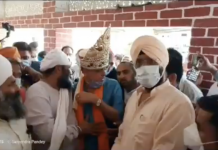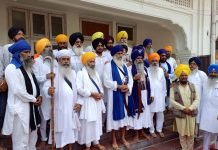

 A little over a year ago, I received a call from my colleagues at the Sikh Coalition requesting to do a Sikh Awareness presentation at a local high school. My knee-jerk reaction was “What happened?” “Was a Sikh boy bullied because of his dastaar?” “Was a Sikh girl suspended because of her kirpan?” “Are the parents involved yet?” Surprisingly though, there was no incident. In fact, there wasn’t even a Sikh attending the school.
A little over a year ago, I received a call from my colleagues at the Sikh Coalition requesting to do a Sikh Awareness presentation at a local high school. My knee-jerk reaction was “What happened?” “Was a Sikh boy bullied because of his dastaar?” “Was a Sikh girl suspended because of her kirpan?” “Are the parents involved yet?” Surprisingly though, there was no incident. In fact, there wasn’t even a Sikh attending the school.
Two week later, I stood before a class of 30 excited Catholic school students and delved into my PowerPoint slides explaining who Sikhs are and what we’re all about. When I got to the slide titled “Guru,” I asked the class, “Does anybody know what the word ‘guru’ means?”A girl eagerly raised her hand and said, “One who takes someone from darkness to light.” I had to pause for a second and collect myself. Clearly, this wasn’t going to be like other presentations. I would later find that the teacher spent the last few weeks researching Sikhi on the internet and had already taught three days of material on the basics. I zipped through the rest of my slides as all my questions were answered with relative ease. And rather than spending the rest of my time answering questions on “Why do you…” and “Are you allowed to…?” We instead focused on much deeper questions:
Under what circumstances would you use your kirpan as a weapon?
How does the Khalsa Panth discuss and resolve issues affecting Sikhs globally today?
Is there a process for repentance in the Sikh faith?
Can someone from the LGBT community take Amrit?
If a Singh is a lion and a Kaur is a princess, how is that a reflection of gender equality?
Do you think Sikhs should have a separate homeland?
It was a fantastic discussion, and it forced me to reflect as opposed to giving the “canned” answers I typically give in such presentations. And in the final minutes, I was asked about my favorite local sports teams and hip hop artists. Although the teacher was slightly embarrassed, I welcomed it, as clearly the students no longer saw me as “the other” walking in to their class room with a turban and long beard, but someone who was like them and someone they wanted to further connect with. I have visited the school every semester since, and our presentation is now part of their standard world religions curriculum.
I try to minimize the time in these presentations on “de-mystifying the kakaars” and instead focus on the dangers of “othering,” the practice of looking at people who are different (race, religion, ethnicity, sexual orientation, etc.), as “them” and not one of “us.” In its most basic forms, it prevents us for learning about one another and finding those mutual values that foster relationships and creates partnerships. In it worst form, it causes violence where innocent people are hurt or killed.
13 years ago, when I started doing Sikh awareness presentations, it came from a place of fear… fear for the safety of my community. My presentation sounded like “Hey, we are American just like you.” Not anymore. Now my presentation sounds like, “Hey, we are American, and we are different… and that’s okay.” In fact, every immigrant who steps foot in this country brings a set of values and traditions to their community – and we can either be afraid of it, isolating them, or we can engage with one another, learn about what makes each of our traditions great. When we do this, we then find ways to partner with one another to build better neighborhoods and healthier communities.
In the case of Sikhs, I make it crystal clear to the students, when you see a Sikh… know that they live a disciplined lifestyle, they spend a good part of their day reflecting on God, and they have a passion for service and social justice. That should be the first thing that comes to your mind. If you’re going to stereotype us for anything, stereotype us for that.
This experience of presenting at schools has taught me a few things:
- We need better materials for non-Sikh educators on Sikhi available for free on the internet. And we should work with Sikh and non-Sikh educators in doing so. More to come on that from the Sikh Coalition… stay tuned!
- We can’t do it alone. I have always said (especially on this blog), that the role of educating people on Sikhi is not solely the responsibility of civil rights organizations or public relations firms. It will take all of us, but what I’ve since learned, is that it will take more than all of us. There are resources outside of our community, all around us, who have the capacity and desire to help… all we need to do is ask. And where better to start than educators? I have always had tremendous respect for the teaching profession, but I’m especially amazed at teachers like the one at the school I visited who decided to teach “outside the book,” to do his own research, and bring in speakers face to face, so we can truly break down barriers. This particular teacher also arranges a trip to the local mosque every semester, where 30 Catholic school students witness Friday prayer. Over lunch, I had to ask him, “Even after bringing in a Muslim speaker, did you still feel it was necessary to take the students to a mosque?” He said, “You know, last time we went to the mosque, in the middle of the prayer, a man was so overwhelmed, he broke down in tears… you can’t teach that in a classroom.” And he’s not alone, months later another inquiry came in from a Social Studies teacher to our Gurdwara’s website with an identical curriculum that we also now contribute to every semester. These teachers are not simply educating, they are building bridges and creating change.
- PowerPoints aren’t enough. For years I’ve stood in front of students pointing at slides talking about how our faith revolves around service and social justice. But at some point, I’ll need to ditch the slides and get to work. It makes me feel so proud when I see gurdwaras and Sikh organizations coming together for a charity event or seva project, but for me personally, I feel I need to take that next step outside of the Gurdwara too, and work shoulder to shoulder with other activists in solving our community’s most pressing needs. Whatever the cause is – climate change, domestic violence, poverty, homelessness, hunger, I need to join the movement around me and wear my kakaars fearlessly. Not only does it deliver more impact to the cause, but it educates others about the “students of Guru Nanak” without even uttering a word. When it comes to educating others about Sikhi, we do not have an “image problem” and we don’t need to re-brand ourselves. Guru Sahib gave me the perfect brand – the god-connected-humanity-loving-injustice-fighting-student… I simply need to live it.





Keep up the good work of presenting Sikhs [your self] as part of the community in which you live.
I agree that we need more free educational material to give out to non sikh.
I am a loner like your self. I have been going to local Gurdwaras
asking for time to express views to the Sangat in english for the benefit of our younger audiance.
Why not take the oppertunity of printing the Guru Granth sahib
in America also some material in english for free distribution
to spread SIKHI.
The SGPC of Amritsar should spend fund for this purpose.
If we[sikh parents] start sending our children to local schools without cutting their Hairs so that the other children and parents can get use to them.
Our GURDWARAS need to teaching about sikhi and not telling old stories in punjabi only.[ Why not in english or other language]